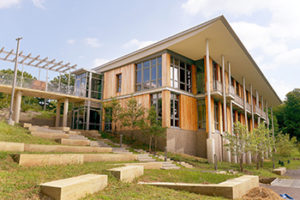Frick Environmental Center Brings Green Design to Urban Community

PITTSBURGH — The Frick Environmental Center has been redesigned into a new interactive facility to bring nature into the community while educating visitors on the importance of green design. The center celebrated its opening on Sept. 16 in Pittsburgh.
Construction on the $19 million, 15,500-square-foot center began in 2015. The center was designed by Wilkes-Barre, Pa.-based architects Bohlin Cywinski Jackson with Pittsburgh-based PJ Dick acting as the general contractor.
“This is designed to be a neighborhood-to-nature project,” said Patricia Culley, project architect with Bohlin Cywinski Jackson, in a statement. “We want to bring people in through the arc of walkways and building and then into the park.”
The three-story environmental center building was designed to replace a classroom building built in 1979 that was destroyed by a fire in 2002, according to the Pittsburgh Post-Gazette.
The entryway welcomes all sizes of visitors by providing adult and child-sized doors. The center also features two indoor and two covered open-air outdoor classrooms as well as a community gathering and reception area, public restrooms and conservancy office space.
“The building was designed to sit out among the trees,” said Scott Roller, Pittsburgh Parks Conservancy spokesman, in a statement. “As the trees grow, the building will all but disappear.”
Visitors will see several unfinished areas around the center building. The interiors of the two historic gatehouses at the Beechwood Avenue entrance remain unfinished, the signature fountain won’t be gurgling, and some of the tree and shrubbery planting has been delayed until completion this fall.
Sustainable features include a solar panel system located over the parking lot that produces enough electricity to meet the power needs of the environmental center building. The solar panel system also collects enough rainwater to supply its non-potable water needs, according to the Pittsburgh Post-Gazette.
Other sustainable features include an outdoor amphitheater that basks in natural light. In addition, a new high-efficiency fountain requires less water and electricity to operate and uses a perimeter of coping stones from the original fountain at that site.
Permeable pavement allows stormwater infiltration on the northern end of the center to be used as part of the center’s design. The 80-foot-long rain veil will fall from the north side of the center during storms. Stormwater retention ponds are located on the south side of the building.
The largest challenge during construction was drilling 18,525-foot-deep geothermal wells into different layers of rock, according to Noah Shaltes, project manager for PJ Dick. The wells will use geothermal energy to heat the building during colder months.
The building is designed to achieve LEED Platinum certification as well as the Living Building Challenge certification from the International Living Future Institute. Only 11 buildings in the world are Living Building Challenge certified.
